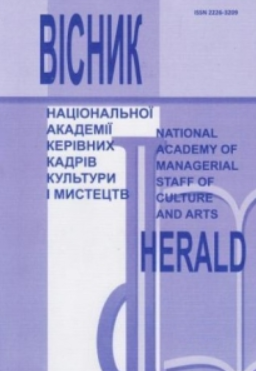ІКОНОГРАФІЯ ПЕРЕПЛЕТЕНИХ ГІЛОК У КРАЄВИДАХ М. БУРАЧЕКА 1917–1924 РР. (ДО ПРОБЛЕМ АДАПТАЦІЇ МОЛОДОПОЛЬСЬКОГО ЯПОНІЗМУ В ТВОРЧОСТІ УКРАЇНСЬКИХ ВИХОВАНЦІВ КРАКІВСЬКОЇ АКАДЕМІЇ МИСТЕЦТВ)
ICONOGRAPHY OF INTERTWINED BRANCHES IN M. BURAČEK’S LANDSCAPES DURING 1917–1924: (REGARDING PROBLEMS OF ADAPTATION OF YOUNG POLISH JAPONISME IN THE WORKS OF UKRAINIAN STUDENTS OF THE KRAKOW ACADEMY OF ARTS)
Author(s): Ivanna Andriyivna PavelchukSubject(s): Cultural history, Visual Arts, Pre-WW I & WW I (1900 -1919), Interwar Period (1920 - 1939), History of Art
Published by: Національна академія керівних кадрів культури і мистецтв
Keywords: art nouveau; Japonisme; Young Poland; landscape genre of kachō-ga; secession; Ukrainian postimpressionism;
Summary/Abstract: The purpose of the article is to analyze M. Buraček’s winter landscapes from the collection of the Zaporizhzhia Art Museum: “Winter” (1917), “Apple Trees in Winter. Dziunkiv”(1922), “Branches in the Hoarfrost”(1924) and to substantiate the reflections associated with the Young Polish Japonisme mastered by the Ukrainian artist while studying at the Krakow Academy of Arts. Methodology. In order to solve the problem set in the publication, the following methods were used: comparative – in connection with clarifying the analogies between the landscapes of M. Buraček of 1917–1924 and the plots of Polish artists of the 1900s; hermeneutic - to understand the connection between the traditions of ukiyo-e Japanese woodblock prints and particularities of the Polish improvisations of early XX century. The scientific novelty of the publication consists in the fact that the works of M. Buraček proposed for consideration are analyzed for the first time in the context of the problem of assimilation of Young Polish Japonisme among Ukrainian students of the Krakow Academy of Arts. Conclusions. It was found that the landscape plots of kachō-ga, inspired by the Polish artistic background, had been adapted in the works of M. Buraček during the period: 1917–1924. The then strivings of the below Krakiw pioneers from Young Poland’s artistic environment contributed to the renewal of M. Buraček’s thematic repertoire: W. Weiss, J. Voinarski, K. Gomolaks, T. Richter, F. Ruszczyc, T. F. Simon, J. Stanislawski, W. Tadeusz, J. Tchaikovsky. The study of the landscape repertoire of M. Buraček during 1917–1924, which had been formed during his studies at the Krakow Academy of Arts, results in confirming the Krakiw Japonisme reflections traced in his works attributable to the first quarter of XX century.
Journal: Вісник Національної академії керівних кадрів культури і мистецтв
- Issue Year: 2021
- Issue No: 2
- Page Range: 122-127
- Page Count: 6
- Language: Ukrainian

